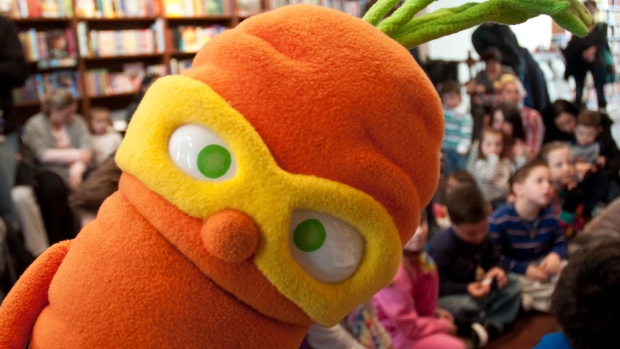Kids may turn their noses up at some vegetables, but when they see superhero characters such as Brian Broccoli and Colby Carrot extolling the virtues of veggies, they may be more eager to load up their salad plates.
Marketing experts found that to be the case when they did a six-week field experiment in 10 U.S. elementary schools.
Marketing to children is controversial in public health circles since the flashy ads and celebrity promotions usually sell unhealthy food and drinks.
In the experiment, researchers harnessed marketing strategies to sway children towards salad. They randomly assigned participating classes to receive:
A vinyl banner displaying vegetable characters that was fastened around the base of the salad bar in the school cafeteria.
Short television clips with nutrition education messages delivered by the same vegetable character superheros, called Super Sprowtz.
A combination of the vinyl banner and television segments.
The animated vegetable characters included Colby Carrot, a joker with super sight, Zach Zucchini, a fast-swimming surfer dude, Suzy Sweetpea, a friendly eager beaver and super strong Brian Broccoli as captain.
Kids and vegetables
Arjun Birak enjoys broccoli after watching animated veggie characters. (CBC)
In schools with the vinyl banners, nearly 91 per cent more students took veggies, an increase from 12.6 per cent to 24 per cent, Andrew Hanks, an assistant professor of consumer sciences at Ohio State University, and his team reported in the journal Pediatrics.
Fruits and vegetables: 6 ways to save money on produce
Sesame Street, heart doctor aim to boost kids’ health
When the kids also saw the videos, the number of kids grabbing greens jumped up 239 per cent, from 10.2 per cent to 34.6 per cent, the researchers said.
Keep it simple pays off
“This was fairly innovative in that something of this nature hadn’t been done in the past,” Hanks said in an interview.
“If we can keep it as simple and least costly as possible then we have a win. It’s a big impact and we can really move the needle in terms of getting people to take more vegetables.”
The simple banner was the more persuasive element, perhaps because it was consistently part of the salad bar, a prime spot where students were making their food choices, the researchers said. The location of TV screens was limited by the location of electrical outlets and wall space.
Alan Middleton, an assistant professor of marketing at the Schulich School of Business at Toronto’s York University who has worked for major advertising firms, watched the videos with a group of children and friends of CBC journalists and gauged their reactions.
“Make it fun, make it enjoyable,” said Middleton. “There is an opportunity of getting them turned on to that as much as they are to the other things.”
Jora Birak, 10, snacked on veggie platters as he watched the videos. “The advertising makes it look better but sometimes it is not,” he said.
Preparing the veggies in such an easy to eat form also helps, Middleton said.
Cauliflower and celery and meat, oh my! Your ideas for tackling rising food prices
Family meals boost children’s fruit and vegetable intake
Whether the marketing tactic will work after the novelty wears off is an open question.
Junk food remains cheap and pumped with preservatives. For families struggling to make ends meet, Middleton said paying more for vegetables will continue to be a barrier as food costs are projected to increase in the next decade.
The challenges come as about one in three children in Canada is overweight or obese.
In an email to CBC News, Health Minister Jane Philpott’s office said evidence has shown marketing unhealthy products influences child obesity and the federal government will introduce new restrictions on its commercial marketing to support families to make better food choices.
SOURCE: CBC News


Be the first to comment on "How Colby Carrot got more kids to choose salad"